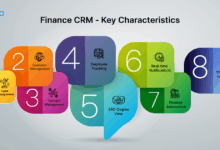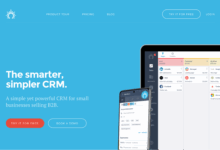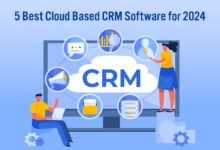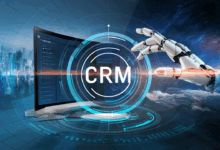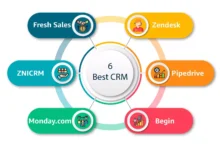CRM for Sales and Marketing Automation
CRM for Sales and Marketing Automation: Unlocking unprecedented growth potential, this powerful combination streamlines processes, improves data visibility, and ultimately drives revenue. By integrating sales and marketing efforts, businesses can nurture leads more effectively, personalize customer interactions, and achieve higher conversion rates. This exploration delves into the core functionalities, benefits, and implementation strategies of a unified CRM system, offering insights into how organizations can leverage this technology to gain a competitive edge.
This comprehensive guide explores the synergistic power of integrating Customer Relationship Management (CRM) with Marketing Automation. We will examine how this unified approach enhances lead generation, nurtures customer relationships, and ultimately boosts sales. From defining core functionalities and outlining key benefits to detailing implementation strategies and exploring future trends, this resource provides a practical roadmap for organizations seeking to optimize their sales and marketing operations.
Defining CRM for Sales and Marketing Automation
A Customer Relationship Management (CRM) system designed for sales and marketing automation is a centralized platform that manages all interactions with current and potential customers. It streamlines processes, automates tasks, and provides valuable insights to improve both sales and marketing efforts, ultimately driving revenue growth. This integration eliminates data silos and fosters a more cohesive approach to customer engagement.
A CRM system for both sales and marketing offers a range of core functionalities. These include contact management (centralized storage and organization of customer data), lead management (tracking potential customers through the sales pipeline), sales pipeline management (visualizing and tracking the progress of sales opportunities), marketing automation (automating marketing tasks like email campaigns and social media posting), reporting and analytics (providing insights into sales and marketing performance), and customer service support (managing customer inquiries and resolving issues). The system’s ability to unify these functions creates a holistic view of the customer journey.
Core Differences Between Sales-Focused and Integrated CRMs
Sales-focused CRMs primarily concentrate on managing the sales pipeline and tracking sales opportunities. They offer features like contact management, opportunity tracking, and sales forecasting. However, they typically lack robust marketing automation capabilities. In contrast, integrated CRMs, encompassing both sales and marketing, add features such as marketing campaign management, lead scoring, email marketing automation, and social media integration. This allows for a more comprehensive approach to customer engagement, from initial lead generation to post-sale support. The key difference lies in the scope: sales-focused CRMs handle the sales process, while integrated CRMs manage the entire customer lifecycle.
Examples of Leveraging Integrated CRM Functionalities
Imagine a company using an integrated CRM. The marketing team uses the system to segment their customer base based on demographics and purchasing behavior. They then launch targeted email campaigns promoting new products to specific segments, automatically tracking open rates and click-through rates. Leads generated from these campaigns are automatically scored based on their engagement, allowing the sales team to prioritize high-potential leads. The sales team then uses the CRM to manage their interactions with these leads, track their progress through the sales pipeline, and ultimately close deals. Post-sale, the system facilitates customer service interactions, gathering feedback to further refine marketing and sales strategies. This seamless flow of information between sales and marketing enhances efficiency and customer satisfaction. Another example could be a real estate agency utilizing the CRM to manage leads from online property listings, track client interactions through email and phone calls, and automate follow-up messages to nurture relationships, ultimately leading to faster sales cycles and increased revenue.
Benefits of Integrated Sales and Marketing Automation
Integrating sales and marketing processes through a unified CRM system offers significant advantages, streamlining operations and boosting overall efficiency. This unified approach eliminates data silos, improves collaboration, and ultimately drives revenue growth. The benefits extend across all aspects of the customer journey, from initial lead generation to final sale and beyond.
Improved data visibility is a cornerstone of successful sales and marketing. A centralized CRM provides a single source of truth, offering a 360-degree view of each customer interaction. This eliminates the confusion and inconsistencies that arise from disparate systems, enabling more informed decision-making and targeted strategies. Sales teams gain access to complete customer histories, enabling personalized interactions, while marketing teams can refine their campaigns based on real-time performance data.
Impact on Lead Generation and Conversion Rates
An integrated CRM significantly enhances lead generation and conversion rates. Marketing automation tools within the CRM allow for targeted campaigns, personalized messaging, and automated lead nurturing. This ensures that the right message reaches the right prospect at the right time, maximizing engagement and conversion opportunities. Sales teams receive qualified leads directly from marketing, reducing wasted time on unqualified prospects and focusing efforts on those most likely to convert. Real-time data tracking allows for immediate adjustments to campaigns, optimizing performance and maximizing ROI. For example, a company might see a 20% increase in lead generation after implementing a CRM with automated email sequences and a 15% increase in conversion rates by utilizing lead scoring and prioritization features.
Key Performance Indicators (KPIs) Before and After Integrated CRM Implementation
The following table illustrates the potential impact of an integrated CRM on key performance indicators. These figures are illustrative and may vary depending on the specific business, industry, and CRM implementation.
| KPI | Before Integration | After Integration | % Change |
|---|---|---|---|
| Lead Generation (per month) | 500 | 750 | +50% |
| Conversion Rate | 5% | 10% | +100% |
| Sales Cycle Length | 30 days | 20 days | -33% |
| Customer Acquisition Cost (CAC) | $500 | $350 | -30% |
Features of a Comprehensive CRM System
A robust CRM system is more than just a contact list; it’s the central nervous system of a successful sales and marketing operation. Its effectiveness hinges on a comprehensive suite of features designed to streamline processes, automate repetitive tasks, and provide valuable insights into customer behavior. The right CRM will seamlessly integrate sales and marketing efforts, creating a unified view of the customer journey and maximizing return on investment.
A comprehensive CRM system offers a diverse range of features categorized broadly into sales automation, marketing automation, and reporting/analytics. Effective integration between these functionalities is crucial for optimizing performance.
Essential Features for Sales Automation
Sales automation within a CRM focuses on streamlining the sales process, from initial contact to closing the deal. These features significantly improve efficiency and allow sales teams to focus on higher-value activities.
- Lead Management: This includes capturing, qualifying, and nurturing leads. Features such as lead scoring, lead routing, and automated email sequences are vital components. For example, a lead scoring system might prioritize leads based on factors like website activity, engagement with marketing emails, and company size.
- Sales Pipeline Management: Visualizing the sales process through a pipeline helps track deals at various stages. This allows for better forecasting and identification of potential bottlenecks. A typical pipeline might include stages like prospecting, qualification, proposal, negotiation, and closing.
- Contact Management: Centralized storage of all customer and prospect information, including contact details, interaction history, and purchase history, ensures everyone has access to the most up-to-date information. This prevents duplication of effort and improves customer service.
- Opportunity Management: Tracking individual sales opportunities, including associated tasks, deadlines, and probabilities of closing, enables effective resource allocation and sales forecasting. This allows sales managers to monitor progress and identify areas needing attention.
- Sales Reporting and Analytics: Analyzing sales data provides insights into sales performance, helping identify top-performing reps, pinpoint areas for improvement, and inform strategic decisions. Dashboards visualizing key metrics such as conversion rates and revenue provide a quick overview of performance.
Essential Features for Marketing Automation
Marketing automation within a CRM aims to nurture leads, personalize communications, and optimize marketing campaigns. These features are critical for improving lead generation and conversion rates.
- Email Marketing: Automated email campaigns, including personalized messages triggered by specific actions (e.g., website visits, form submissions), are essential for nurturing leads and building relationships. A/B testing capabilities allow for optimization of email content and subject lines.
- Campaign Management: This involves planning, executing, and analyzing marketing campaigns across various channels. Features like campaign tracking, segmentation, and reporting provide insights into campaign effectiveness.
- Social Media Integration: Connecting the CRM to social media platforms enables monitoring of brand mentions, engaging with potential customers, and tracking social media campaign performance.
- Marketing Analytics: Analyzing marketing data helps measure the ROI of marketing campaigns and identify areas for improvement. Key metrics include website traffic, lead generation, and conversion rates.
- Workflow Automation: Automating repetitive marketing tasks such as email sequences, social media posting, and lead scoring frees up marketing teams to focus on strategic initiatives.
Comparison of CRM Platforms Based on Sales and Marketing Automation Capabilities
Different CRM platforms offer varying levels of sales and marketing automation capabilities. For example, Salesforce offers a comprehensive suite of tools, including Sales Cloud and Marketing Cloud, while HubSpot provides a more integrated platform combining CRM, marketing automation, and sales tools. Smaller businesses might opt for simpler platforms like Zoho CRM, which offers a balance of features and affordability. The choice depends on the specific needs and budget of the organization. Consider factors such as the size of the sales and marketing teams, the complexity of the sales process, and the level of integration required when making a selection. A detailed comparison of features and pricing across different platforms is essential before making a decision.
Implementing and Managing a CRM System
Successfully implementing a CRM system requires a well-defined plan and ongoing commitment. A phased approach minimizes disruption and maximizes user adoption, leading to a smoother transition and quicker realization of benefits. Effective management ensures the system remains a valuable asset, adapting to evolving business needs.
Step-by-Step CRM Implementation Plan
A structured implementation plan is crucial for a successful CRM rollout. This plan should outline key stages, timelines, and responsibilities, ensuring all stakeholders are aligned. Failing to plan properly can lead to delays, cost overruns, and ultimately, underutilization of the system.
- Needs Assessment and System Selection: Define specific business needs, evaluate different CRM solutions based on those needs (considering scalability, features, and budget), and select the most appropriate system. This stage involves thorough research and potentially soliciting proposals from multiple vendors.
- Data Migration and Cleansing: Migrate existing customer data into the new CRM system. This process requires careful planning and execution to ensure data accuracy and integrity. Data cleansing, including deduplication and standardization, is vital for maximizing data quality.
- System Configuration and Customization: Configure the CRM system to match the specific workflows and requirements of the business. This might involve customizing fields, creating workflows, and integrating with other systems. Thorough testing is essential at this stage.
- User Training and Adoption: Provide comprehensive training to all users, focusing on practical application and ongoing support. Regular refresher courses and readily available resources are key to sustaining user engagement.
- Go-Live and Post-Implementation Support: Launch the CRM system and provide ongoing support to address any issues or questions. Monitor system performance and user feedback to identify areas for improvement.
- Ongoing Optimization and Maintenance: Regularly review and update the CRM system to ensure it continues to meet the evolving needs of the business. This includes adding new features, refining workflows, and ensuring data accuracy.
Data Migration and Integration Best Practices
Data migration is a critical phase, demanding meticulous planning to prevent data loss or corruption. Effective integration with existing systems streamlines workflows and avoids data silos.
Best practices include:
- Data Cleansing Before Migration: Identify and correct inconsistencies, duplicates, and outdated information in existing data sources before migrating to the new system.
- Phased Migration Approach: Migrate data in stages, allowing for testing and validation at each step. This minimizes the risk of widespread errors.
- Data Mapping and Transformation: Clearly define how data from existing systems will map to the fields in the new CRM system. Data transformation may be required to ensure consistency.
- Robust Testing and Validation: Thoroughly test the migrated data to ensure accuracy and completeness. Compare data before and after migration to identify any discrepancies.
- Integration with Existing Systems: Use APIs or other integration tools to connect the CRM system with other business applications, such as marketing automation platforms, e-commerce systems, and accounting software. This ensures data flows seamlessly between systems.
User Training and Ongoing Support Strategies
Effective training is crucial for maximizing user adoption and ensuring the CRM system is used correctly. Ongoing support helps address issues and encourages continuous improvement.
Strategies include:
- Comprehensive Training Programs: Offer a mix of training methods, including online tutorials, classroom sessions, and on-the-job coaching, catering to different learning styles.
- User Manuals and Help Desk Support: Provide easily accessible user manuals, FAQs, and a dedicated help desk to address user questions and technical issues.
- Regular Refresher Courses: Offer periodic refresher courses to reinforce training and address new features or updates to the system.
- Gamification and Incentives: Use gamification techniques and incentives to encourage user engagement and adoption of the CRM system.
- Feedback Mechanisms: Establish feedback mechanisms to collect user input and identify areas for improvement in the system or training materials.
Measuring the Return on Investment (ROI) of a CRM System
Measuring the ROI of a CRM system requires a multi-faceted approach, tracking key performance indicators (KPIs) to demonstrate its value. This helps justify the investment and demonstrate the system’s contribution to business goals.
Methods for measuring ROI include:
- Increased Sales Revenue: Track the increase in sales revenue attributable to improved lead management, sales forecasting, and customer relationship management.
- Improved Sales Cycle Length: Measure the reduction in the time it takes to close deals, reflecting efficiency gains from the CRM system.
- Reduced Customer Acquisition Costs: Track the decrease in the cost of acquiring new customers due to improved targeting and lead nurturing.
- Enhanced Customer Retention Rates: Monitor the improvement in customer retention rates, indicating increased customer loyalty and satisfaction.
- Improved Sales Team Productivity: Measure the increase in sales team productivity, reflecting the time saved through automated tasks and streamlined workflows.
Case Studies and Best Practices
Successful CRM implementations are not merely technological upgrades; they represent strategic shifts that significantly impact sales and marketing performance. Understanding how different organizations have leveraged CRM to overcome challenges and achieve measurable results provides invaluable insights for planning and executing your own CRM strategy. Examining these case studies illuminates best practices and common pitfalls to avoid.
Numerous companies across diverse industries have successfully integrated CRM systems to streamline operations and boost revenue. These successes stem from a combination of careful planning, effective implementation, and ongoing optimization. The following examples showcase how different organizations have achieved tangible improvements in sales and marketing efficiency by adopting and adapting CRM solutions to their specific needs.
CRM Success in the Tech Industry: Salesforce’s Implementation
Salesforce, a leading CRM provider, uses its own platform internally. This allows for a deep understanding of their product and the ability to continuously refine its capabilities. Their implementation focused on improving sales forecasting, lead management, and customer service. By centralizing customer data and automating repetitive tasks, Salesforce streamlined its sales process, increased sales conversion rates, and improved customer satisfaction. Their internal use serves as a compelling example of a company fully embracing its own solution.
CRM Success in the Retail Sector: Sephora’s Personalized Customer Experience
Sephora, a major cosmetics retailer, utilizes CRM to personalize the customer experience. They leverage data collected through their loyalty program and online interactions to tailor marketing campaigns and product recommendations. This personalized approach has fostered customer loyalty, increased sales, and enhanced brand engagement. Sephora’s success demonstrates the power of CRM in creating a more targeted and effective marketing strategy.
Case Study Table: CRM Implementation Successes
| Company | Industry | Challenge | Solution | Result |
|---|---|---|---|---|
| Salesforce | Technology | Inefficient sales processes, lack of centralized customer data | Implementation of Salesforce CRM, automation of sales tasks, improved data analysis | Increased sales conversion rates, improved sales forecasting accuracy, enhanced customer service |
| Sephora | Retail | Difficulty personalizing customer experience, lack of targeted marketing | Integration of CRM with loyalty program, personalized marketing campaigns, data-driven product recommendations | Increased customer loyalty, higher sales, improved brand engagement |
| HubSpot | Marketing Software | Managing inbound leads and tracking marketing ROI | Implementation of HubSpot CRM, automating lead nurturing, tracking marketing performance metrics | Improved lead conversion rates, increased marketing ROI, better understanding of customer journey |
Overcoming Common CRM Implementation Challenges
Effective CRM implementation requires careful planning and execution to overcome common hurdles. Resistance to change from employees unfamiliar with new systems is a frequent obstacle. This can be addressed through comprehensive training programs, clear communication of the benefits of the CRM system, and active involvement of employees in the implementation process. Data migration and integration issues also pose significant challenges. Addressing this requires meticulous planning and the use of appropriate data migration tools to ensure data accuracy and integrity. Finally, inadequate user adoption can hinder the success of a CRM system. This can be mitigated by providing ongoing support, regular training, and user-friendly interface design.
Future Trends in CRM for Sales and Marketing Automation
The landscape of Customer Relationship Management (CRM) is rapidly evolving, driven by advancements in technology and shifting customer expectations. The integration of artificial intelligence (AI) and machine learning (ML) is fundamentally reshaping CRM functionality, leading to more predictive, personalized, and efficient systems. This section explores key future trends in CRM for sales and marketing automation.
The Impact of AI and Machine Learning on CRM
AI and ML are transforming CRM systems from simple data repositories into powerful predictive engines. AI-powered CRM can analyze vast amounts of customer data to identify patterns and predict future behavior, enabling businesses to proactively address customer needs and personalize interactions. Machine learning algorithms can automate tasks like lead scoring, segmentation, and campaign optimization, freeing up sales and marketing teams to focus on strategic initiatives. For example, AI can analyze past sales data to predict the likelihood of a lead converting into a customer, allowing sales teams to prioritize their efforts on high-potential prospects. Similarly, ML algorithms can personalize email marketing campaigns by tailoring content to individual customer preferences, increasing engagement and conversion rates. This leads to improved efficiency and a higher return on investment (ROI).
Future Developments in CRM Functionality
Several key developments are anticipated in CRM functionality. One significant trend is the increasing integration of CRM with other business applications, creating a unified view of the customer across all touchpoints. This holistic approach will enable businesses to gain a deeper understanding of customer behavior and deliver more seamless and personalized experiences. Another key development is the rise of predictive analytics, which will allow businesses to anticipate customer needs and proactively address potential issues. This could include predicting customer churn, identifying opportunities for upselling or cross-selling, and optimizing marketing campaigns for maximum impact. Furthermore, we can expect to see more sophisticated automation capabilities, including the use of robotic process automation (RPA) to automate repetitive tasks and free up human resources for more strategic work.
CRM Adaptation to Changing Customer Expectations and Market Trends
Customers today expect personalized and seamless experiences across all channels. CRM systems will need to adapt to meet these evolving expectations by providing more sophisticated personalization capabilities, omnichannel integration, and improved data privacy and security. Market trends such as the increasing use of mobile devices and social media will also influence CRM development. CRM systems will need to incorporate these channels into their functionality to provide a consistent and engaging customer experience. For instance, a CRM system might integrate with a customer’s preferred social media platform to provide personalized offers or resolve issues quickly. Companies like Salesforce are already adapting by constantly upgrading their platforms to integrate these emerging channels and functionalities.
Innovative CRM Applications and Their Potential Benefits
Several innovative CRM applications are emerging, offering significant benefits to businesses. One example is the use of conversational AI, such as chatbots, to provide instant customer support and answer frequently asked questions. This can improve customer satisfaction and reduce the workload on customer service teams. Another innovative application is the use of augmented reality (AR) and virtual reality (VR) to enhance customer engagement and provide immersive brand experiences. Imagine a furniture retailer using AR to allow customers to visualize how a piece of furniture would look in their home before purchasing it. This can significantly increase sales conversions and improve customer satisfaction. Finally, the increasing use of predictive analytics in CRM systems allows for more proactive and personalized marketing campaigns, leading to improved ROI and customer loyalty. Companies like Netflix use sophisticated recommendation engines powered by predictive analytics within their CRM systems to personalize content suggestions and improve customer retention.
Final Conclusion
In conclusion, implementing a CRM for Sales and Marketing Automation is a strategic investment that promises significant returns. By streamlining processes, enhancing data visibility, and personalizing customer interactions, businesses can achieve substantial improvements in lead generation, conversion rates, and overall revenue. Embracing this integrated approach not only optimizes efficiency but also empowers organizations to build stronger, more profitable customer relationships, paving the way for sustained growth and market leadership.

